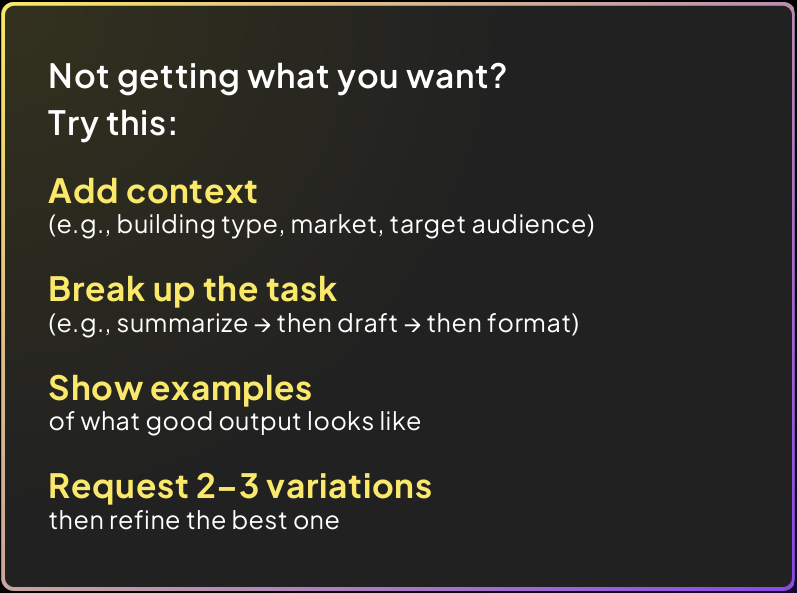The future of commercial real estate will be built – not just with steel and glass – but with words. Specifically, well-crafted AI prompts!
At CRE Agents, we’re building the first AI agentic platform specifically for CRE teams. While the doors aren’t open yet, we’re already helping early adopters get more from the tools they’re using today. That starts with mastering the art of prompting.
This guide breaks down how to write prompts that turn ChatGPT and similar tools into capable, CRE-savvy assistants. Whether you’re drafting marketing copy, analyzing leases, or automating reporting, this framework helps you go from “meh” to mission-critical output.
Why Prompting Matters in CRE
Generic prompts yield generic results. And in commercial real estate—where nuances matter and decisions move millions—there’s no room for vague.
Think of AI like a junior team member. It needs role clarity, context, and a clearly defined task to succeed. This is where prompt engineering comes in. Done well, it transforms AI from a novelty into an extension of your team.
Three Steps to Better CRE Prompts
1. Set the Stage (Context)
Assign the AI a role and provide market-specific context. For example:
Bad Prompt:
“Summarize this lease.”
Great Prompt:
“You’re a senior lease administrator reviewing a 150,000 SF warehouse lease in Dallas. Extract key financial terms, identify landlord vs. tenant responsibilities, and flag unusual clauses related to operating expenses or termination.”
Why it works: You’ve given the AI a job title, location, document type, and clear expectations.
2. Define the Task (Action)
Spell out exactly what you want the AI to do. Break up complex tasks and use strong action verbs.
Bad Prompt:
“Write a property marketing plan.”
Great Prompt:
“You’re a CRE marketing director. Develop a leasing strategy for a 200,000 SF Class A office tower in Downtown Chicago. Include: 1) digital outreach, 2) broker engagement tactics, 3) incentives for tech tenants.”
Why it works: It’s focused, structured, and tailored to your audience.
3. Specify the Output (Format)
Tell the AI what the output should look like—word count, tone, format, etc.
Bad Prompt:
“Create a flyer.”
Great Prompt:
“Create one-page flyer copy for a Scottsdale medical office. Use persuasive language. Include: 1) headline, 2) 3 selling points, 3) tenant roster, and 4) CTA for tours. Limit to 300 words.”
Why it works: The AI knows the tone, structure, and length—resulting in use-ready content.
Three Power Tips for CRE Prompting
- Assign Roles – The more specific the persona, the better the result.
- Set Constraints – Guardrails drive better outputs. Include word limits, deadlines, or stylistic preferences.
- Request Variations – Ask for 2–3 options with different tones or angles. Then choose and refine.
Ready to Level Up Your AI Game?
We put together a free guide that walks through everything above, with real-world examples for leasing, analysis, marketing, and more. If you’re on the CRE Agents waitlist, you’ve probably already received it in your inbox.
👉 Download the AI Prompting Guide for CRE
Inside, you’ll find:
- Prompt templates tailored for CRE roles
- Techniques to drive consistent, actionable responses
- Tips to avoid vague output and accelerate workflows
Whether you’re just starting to explore AI or you’re already integrating it into your deal cycle, this guide will help you get more out of the tools you already use.
Big things are coming soon. And we can’t wait to show you what’s next. Join the waitlist to be among the first to use digital coworkers for real estate!

